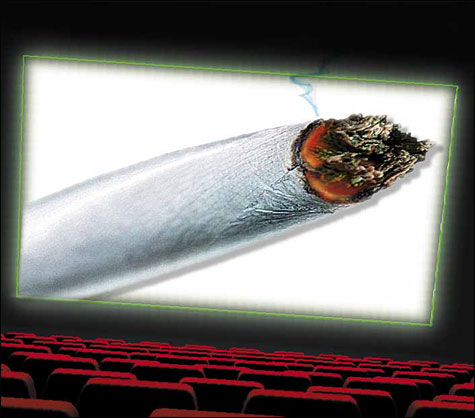
K.Banks.
I don’t much like getting stoned — it makes me stupid and paranoid (some may say not much different from my usual frame of mind). But I do like watching other people get stoned in the movies. Vicariously enjoying the pleasure of others onscreen, that’s the definition of a movie critic. Though the chances of my wanting to get high after watching, say, The Wackness, are slight, I just might crave seeing more films in which the protagonists inhale. And, as stoner movies might be gateway films, perhaps I’d then want to see movies about harder drugs, such as peyote, LSD, heroin, and crack. I might down a couple of bags of Cheetos and a box of Yodels while I’m at it.

It’s spread from the big screen to the tube, too: Weeds, a series about a suburban widow who pays the bills by dealing (a premise stolen from the 2000 British comedy Saving Grace), is in its fourth season on Showtime. Seth Rogen and James Franco of Pineapple Express also stirred controversy (and hyped publicity for their film) this past June by “pretending” to light up while presenting on the broadcast of the MTV Movie Awards. But for the most part, you’re safer from the FCC and the MPAA these days smoking a joint than smoking a cigarette. (For more info on the recent push to ban cigarettes, see “Outlawing Cigarettes: Beginning Another Hopeless Drug War?” at thePhoenix.com/blogs/freeforall.)
Meanwhile, as usual, real life tries to keep up with Hollywood. In Congress recently, Massachusetts’s own Democratic representative Barney Frank and Texas Republican representative Ron Paul proposed House Bill 5843, which if passed would end federal penalties for Americans carrying fewer than 100 grams of marijuana. The executive branch, though, is way ahead of them. Our past two presidents (and maybe the next one, too), have admitted (sort of) to lighting up — if not inhaling — the chronic. (We’ll get more details on herb habits of the current holder of the highest office in the land when Oliver Stone’s W. opens October 17.)
So, isn’t this long-overdue tolerance for, and possible legalization of, marijuana a good thing? I’d like to think so. Still — and it could be the second-hand smoke from all these marijuana movies talking — I feel like there’s something funny going on. I’m sure of it — I’m just not sure what it is. (Er, can you pass the Twizzlers?)
Reefer badness
No such ambiguities wafted about the drug seven decades ago. When Prohibition ended in 1933, an entire federal bureaucracy was sitting around doing nothing, waiting for the axe to fall. So Harry J. Anslinger, assistant prohibition commissioner in the then–Bureau of Prohibition, pushed to make dope the new scourge of the nation. Aided by a propaganda campaign of films and newspaper articles (William Randolph Hearst also had it in for hemp, because it was an alternative source of paper and he had invested heavily in wood pulp), Anslinger effectively demonized the drug. As a result, the “Marihuana Tax Act” was passed by Congress without much resistance in 1937, outlawing marijuana (and hemp) to the present day.
Thus was the stoner-movie genre born, a step-child of Anslinger’s efforts. One of the first of its kind, Reefer Madness (1936; originally titled Tell Your Children), actually started life as an earnest if utterly fraudulent harangue against the dangers of pot. A church group had produced it, but an exploitation studio bought it, spiced it up with some lurid footage, and passed it off as an educational film in order to do an end-run around the puritanical standards of the Hollywood Production Code of 1934.
The opening admonitory title-card prologue promises a good time:
Marihuana is a violent narcotic — the Real Public Enemy Number One! . . . Its first effect is sudden, violent, uncontrollable laughter; then come violent hallucinations . . . the loss of all power to resist physical emotions . . . leading finally to acts of shocking violence ending . . . in insanity . . .